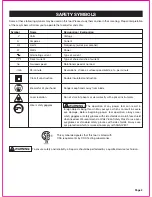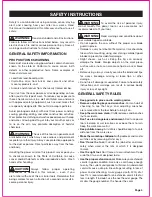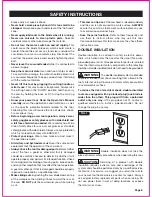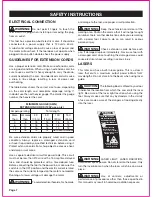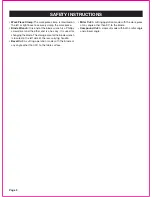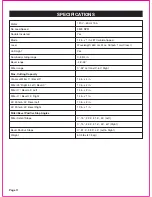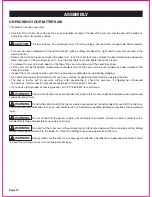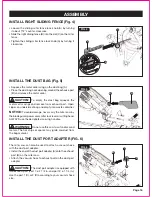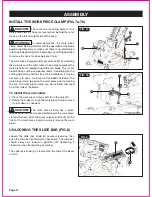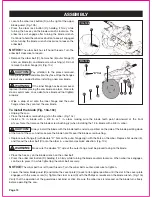
•
Always wear eye protection.
•
Do not operate the saw without the guard in place.
•
Be sure to turn the tool off and wait for the saw blade
to stop
before moving the work piece or changing
the settings.
•
Be sure that the power is disconnected
before changing
SPECIFIC SAFETY RULES
•
Wear proper apparel.
Do not wear loose clothing, gloves,
neckties, rings, bracelets, or other jewelry that can get
caught in moving parts. Non-slip footwear is recommended.
Wear protective hair covering to contain long hair.
•
Always use safety glasses.
Also use a face mask or dust
mask if the cutting operation is dusty. Everyday eyeglasses
only have impact resistant lenses. They are not safety
glasses.
•
Secure the work piece.
Use clamps or a vise to hold the
work piece whenever practical. It’s safer than using your
hand and it frees both hands to operate the tool.
•
Don’t over reach.
Keep proper footing and balance at
all times.
•
Maintain tools with care.
Keep tools sharp and clean for
the best and safest performance. Follow instructions for
lubricating and changing accessories.
•
Disconnect tools
before servicing and when changing
accessories, such as blades, bits, cutters, and the like.
•
Reduce the risk of unintentional starting.
Make sure
that the switch is in the off position before plugging the
tool into an electrical outlet.
•
Use recommended accessories.
Consult the operator’s
manual for recommended accessories. The use of improper
accessories may cause a risk of injury to persons.
•
Never stand on the tool.
Serious injury could occur if the
tool is tipped or it the cutting tool is contacted
unintentionally.
•
Check for damaged parts.
Before further use of the tool,
a guard or other part that is damaged should be carefully
checked to determine whether it will operate properly and
perform its intended function. Check for misalignment or
binding of moving parts, broken parts or mountings, and
any other condition that may affect the operation of the
tool. A guard or other part that is damaged should
be properly repaired or replaced.
•
Direction of feed:
Always feed work piece into a blade or
cut against the direction of rotation of the blade or cutter.
•
Never leave a tool running unattended. Turn the power
off.
Don’t leave the tool until it comes to a complete stop.
the blade or servicing the saw.
•
Do not expose to rain or use in a damp location.
•
When servicing, use only identical replacement parts.
•
Never reach around the saw blade.
•
Do not perform any operation freehand.
Always place
the work piece to be cut on the miter saw table,
and position it firmly against the fence as a backstop.
Always use the fence.
•
Always keep hands out of the path of the saw blade.
Do not
reach under the material being cut or into
the blade’s cutting path with your fingers or hand for any
reason.
•
To reduce the risk of injury,
return the cutting head to
the full rear position after each crosscut operation.
•
Always make sure that the miter table and saw arm
(bevel function) are locked in position before operating
your saw.
Lock the miter table by securely pushing down
the miter lock lever. Lock the saw arm (bevel function) by
securely tightening the bevel lock lever.
•
Be sure that the blade path is free of nails.
Always
carefully inspect lumber and remove all nails before
cutting.
•
Always be sure that the blade clears the work piece.
Never start the saw with the blade touching the work piece.
Always allow the motor to come to full speed before
starting a cut.
•
Support long work pieces when cutting
to minimize the
risk of blade pinching or kickback. The saw may slip, walk
or slide while cutting long or heavy boards.
•
Never use a length-stop on the free (scrap) end of a
clamped work piece; Never hold onto or bind the free
(scrap) end of the work piece in any operation.
If
a clamp and a length-stop are used together, they must
both be installed on the same side of the saw table
to prevent the saw from catching the loose end and kicking
up.
•
Never cut more than one piece at a time.
Do not stack
more than one work piece on the work table at a time.
•
Avoid awkward operations and hand positions
where
a sudden slip could cause your hand to move into
the blade. Always make sure that you have good balance.
Never operate your saw on the floor or in a crouched
position.
•
Only use the correct blades.
Use the correct blade size,
style and cutting speed for the material and the type of
cut. Do not use blades with incorrect size holes. Never
use blade washers or arbor bolts that are defective
or incorrect.
•
Always keep blades clean, sharp and with sufficient
set.
Sharp blades minimize stalling and kickback.
•
Do not use dull or damaged blades.
Bent blades can
SAFETY INSTRUCTIONS
Page 5
WARNING:
For your own safety, read the operator’s
manual before operating the miter saw.
Содержание 240-0028
Страница 44: ......



